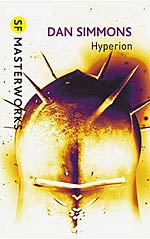
![]() verkisto
verkisto
7/26/2016
![]()
With Hyperion, I've started on the last series in my Unfinished Series project, which I started last summer. This is another series where I'm re-reading part of it before finishing it off, and I remember liking Hyperion a lot when I first read it back in college. I remembered bits and pieces of it -- the Treeship Yggdrasil; the story of Sol Weintraub and his daughter; the Shrike -- but for the most part I didn't remember the details of the entire novel. What I did recall was the humanism of the story, and how much it resonated with me beyond the story itself.
I enjoyed this novel a great deal, partly due to nostalgia, but namely because this is an incredible story. It borrows the structure of The Canterbury Tales, with a group of pilgrims on a holy journey sharing his or her story along the way. This structure gives the novel a feeling of being more a collection of short novels than a proper novel, but the common theme of the Hegemony and the Shrike bring the stories together into a collective instead of each story standing alone. Some of the stories are more memorable than others -- Sol Weintraub's story is probably the most memorable, despite it not being the one that inspired the novel (the Consul's story was that one) -- and the plot for the overarching story is minimal compared to those of the pilgrims' stories, but it's all woven together brilliantly. Not only do we learn more about what brought each of the pilgrims to journey to the Shrike's Time Tombs, but we also slowly learn of the history of the Hegemony and their building of the WorldWeb, which is an important component of the overarching story behind each of the pilgrims' tales.
Woven throughout the stories is a heavy literary influence, mostly related to John Keats and his poetry. The name of the titular planet and its home city are named after Keats and his work, and one story (a well-crafted pastiche of the hard-boiled mystery) features a character who is based heavily on Keats. Additionally, one of the pilgrims is a profane poet striving to finish his life's work, and the individual stories have other literary references, such as an allusion to Romeo and Juliet in the Consul's tale. Having read Simmons before, I wasn't surprised by any of these references, but that they existed in the story in such a way without having it feel clunky or forced was impressive.
The book finishes without having resolved much of the overarching story, but I think this novel was intended to set the stage for that part of the story while also giving us the details we needed to know about the individual pilgrims. It seems like this book and its sequel, The Fall of Hyperion, are less two different novels, and more one novel split into two parts. I'll be starting the next book in the sequence soon, so once I finish that one, I can report back with whether or not I was right. At the very least, I expect that I will enjoy the book.